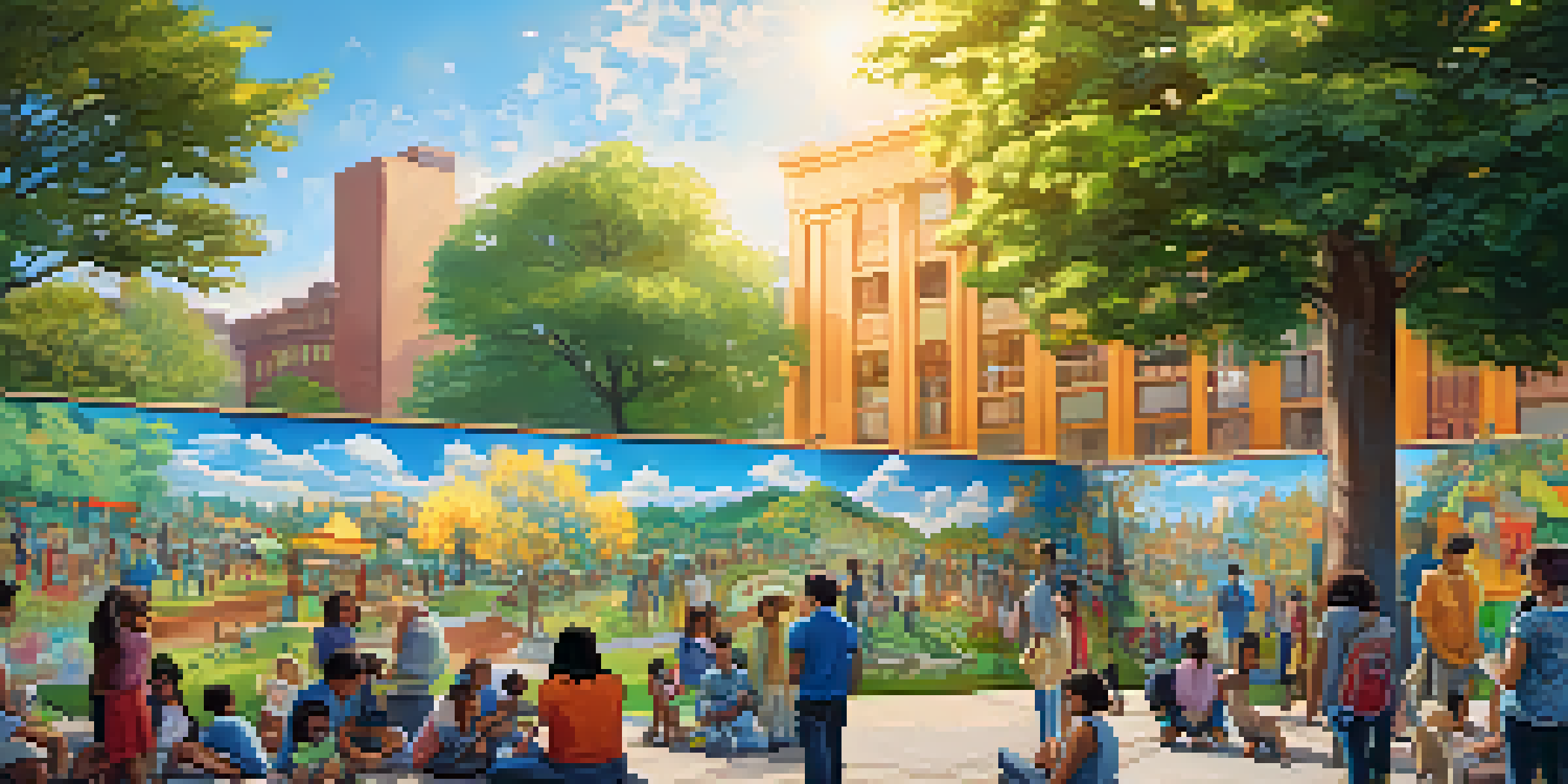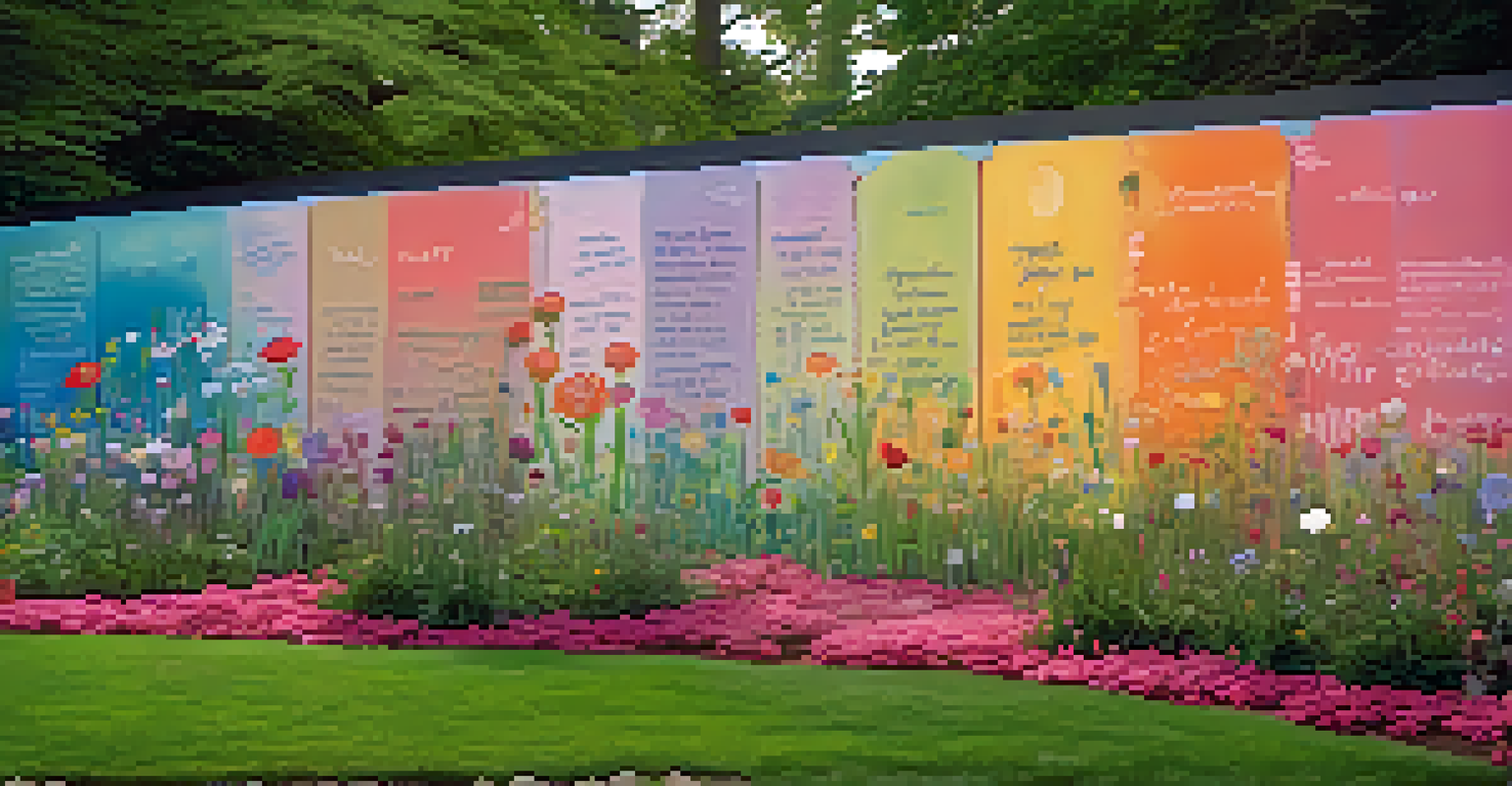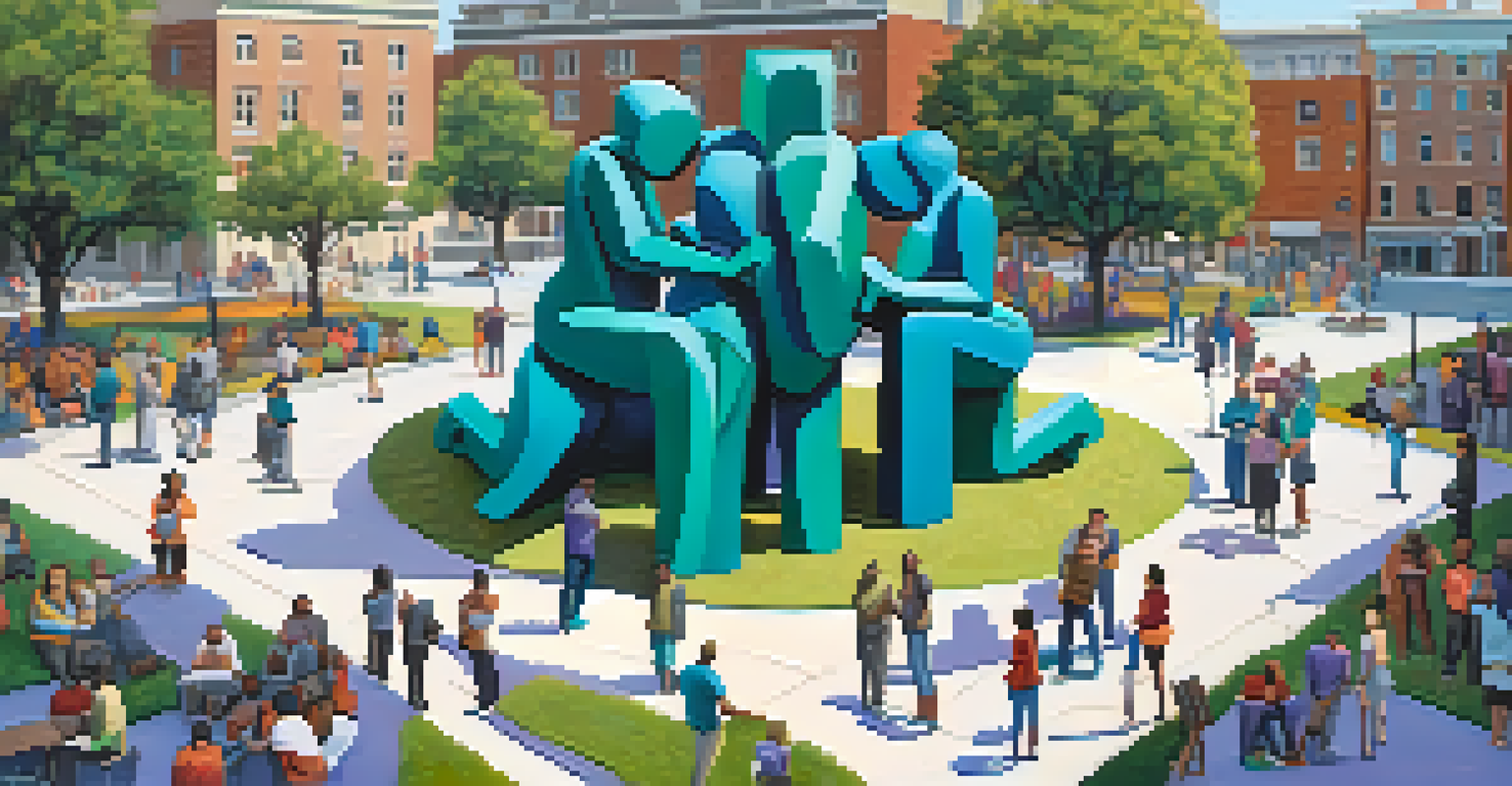Public Art and Mental Health: Creating Healing Spaces

Understanding Public Art and Its Impact on Communities
Public art encompasses a wide array of artistic expressions displayed in public spaces, from murals to sculptures. These artworks often reflect the culture and values of the community, serving as a visual narrative of its identity. By providing a shared space for appreciation, public art fosters a sense of belonging and connection among residents.
Art is the most beautiful of all lies; it is the truth. It is a mirror of our emotions.
Moreover, public art can act as a catalyst for community engagement. When people gather around art installations, they naturally start conversations and share experiences, which can strengthen social ties. This communal aspect is vital, as strong social connections are linked to improved mental health.
In essence, public art transforms ordinary spaces into extraordinary experiences, inviting individuals to reflect and engage. Whether it's a colorful mural brightening a dull wall or a thought-provoking sculpture in a park, these artistic interventions create environments that nurture well-being.
The Connection Between Art and Mental Health
Art has long been recognized for its therapeutic benefits, with research showing that engaging in creative activities can reduce stress and anxiety. Whether creating art or simply appreciating it, individuals often find solace and escape from their daily challenges. This connection becomes even more significant in public spaces, where art can touch the lives of many simultaneously.

For instance, public art can provide a platform for expressing emotions and experiences that might be difficult to articulate otherwise. A mural that addresses mental health stigma, for example, can resonate deeply with individuals who feel isolated in their struggles. This validation can promote healing and foster a sense of community support.
Public Art Fosters Community Bonds
Public art serves as a visual narrative, enhancing community identity and strengthening social ties among residents.
Furthermore, the presence of art in public spaces can enhance the overall atmosphere, making environments feel more welcoming and inclusive. When people feel comfortable in their surroundings, they are more likely to engage with others and seek help when needed, ultimately benefiting their mental health.
Creating Safe Spaces Through Public Art Initiatives
Public art initiatives can be designed specifically to create safe and healing spaces for individuals experiencing mental health challenges. For example, community gardens adorned with vibrant murals can serve as tranquil retreats where people can relax and recharge. These spaces encourage mindfulness, allowing individuals to step away from their daily pressures.
Public art is an opportunity for communities to engage with their environment and create a shared identity.
Moreover, collaborative projects can empower community members, giving them a voice in the creation process. When individuals contribute to the art that represents their community, they feel a sense of ownership and pride. This investment can lead to increased self-esteem and a sense of purpose, both crucial for mental well-being.
Such initiatives not only beautify neighborhoods but also cultivate resilience within communities. By prioritizing mental health in public art projects, cities can become more supportive environments where everyone feels valued and understood.
The Role of Interactive Art in Mental Health
Interactive public art installations invite participation and engagement, which can have profound effects on mental health. They provide individuals with the opportunity to express themselves creatively, fostering a sense of connection with others and the artwork itself. Whether it's a chalk wall encouraging messages of hope or a sculpture that invites touch, these experiences can uplift spirits.
For example, a project that encourages community members to paint tiles with personal stories can transform a public space into a living tapestry of shared experiences. This collective expression not only beautifies the area but also creates a dialogue around mental health, breaking down barriers and encouraging understanding.
Art Supports Mental Health Awareness
Engaging with public art can spark essential conversations about mental health, helping to normalize discussions and reduce stigma.
Interactive art thus serves as a powerful tool for healing, allowing individuals to process their emotions while engaging with others. By facilitating these connections, public art can play a crucial role in building a supportive community focused on mental well-being.
Art as a Tool for Raising Mental Health Awareness
Public art can be a potent medium for raising awareness about mental health issues. Murals and installations that address topics like depression, anxiety, and stigma can spark important conversations within communities. By bringing these issues into the open, public art helps to normalize discussions around mental health.
For instance, an art installation that visually depicts the journey of mental health struggles can resonate with many individuals, prompting them to share their own stories. This not only empowers those who feel silenced but also educates the wider community about the challenges faced by others.
Ultimately, using public art as a platform for advocacy can lead to increased understanding and compassion. As communities engage with these artworks, they become more informed and supportive, creating an environment where mental health is prioritized and openly discussed.
Case Studies: Successful Public Art Projects
Several cities have successfully integrated public art initiatives aimed at enhancing mental health. For example, the 'Mental Health Mural Project' in San Francisco transformed blank walls into vibrant murals that depict mental health themes, offering hope and encouragement. These murals have not only beautified the city but also sparked important conversations within the community.
Another notable example is the 'Before I Die' wall project, which invites people to write down their hopes and dreams on a public wall. This interactive installation fosters reflection and connection, allowing individuals to share their aspirations while also confronting their mental health challenges. It serves as a reminder that they are not alone in their struggles.
Interactive Art Encourages Healing
Interactive public art installations allow individuals to creatively express themselves, fostering connections and promoting mental well-being.
These case studies highlight the transformative power of public art in promoting mental well-being. By focusing on community engagement and awareness, these projects not only enhance the aesthetic appeal of urban spaces but also address critical issues related to mental health.
The Future of Public Art and Mental Health Collaboration
As the conversation around mental health continues to evolve, the role of public art will undoubtedly expand. Future collaborations between artists, mental health professionals, and community organizations can lead to even more innovative projects that prioritize healing and connection. By integrating art into mental health initiatives, we can create environments that foster well-being.
For instance, cities could develop art therapy programs in public spaces, where community members can engage in creative activities while receiving mental health support. This approach not only promotes healing but also reinforces the idea that mental health is a community concern, requiring collective effort.

In conclusion, the future of public art and mental health collaboration holds great promise. By harnessing the power of art to create healing spaces, communities can cultivate resilience, understanding, and compassion for all.